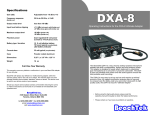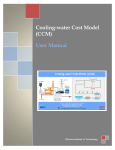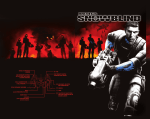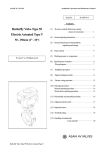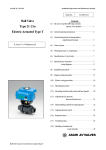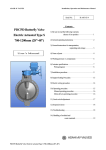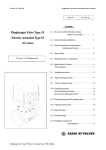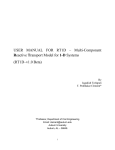Download Troubleshooting the Sequencing Batch Reactor
Transcript
Troubleshooting the Sequencing Batch Reactor Michael H. Gerardi Illustrations by Brittany Lytle A John Wiley & Sons, Inc., Publication Troubleshooting the Sequencing Batch Reactor WASTEWATER MICROBIOLOGY SERIES Editor Michael H. Gerardi Nitrification and Denitrification in the Activated Sludge Process Michael H. Gerardi Settleability Problems and Loss of Solids in the Activated Sludge Process Michael H. Gerardi The Microbiology of Anaerobic Digesters Michael H. Gerardi Wastewater Pathogens Michael H. Gerardi and Mel C. Zimmerman Wastewater Bacteria Michael H. Gerardi Microscopic Examination of the Activated Sludge Process Michael H. Gerardi Troubleshooting the Sequencing Batch Reactor Michael H. Gerardi Troubleshooting the Sequencing Batch Reactor Michael H. Gerardi Illustrations by Brittany Lytle A John Wiley & Sons, Inc., Publication Copyright © 2010 by John Wiley & Sons, Inc. All rights reserved Published by John Wiley & Sons, Inc., Hoboken, New Jersey Published simultaneously in Canada No part of this publication may be reproduced, stored in a retrieval system, or transmitted in any form or by any means, electronic, mechanical, photocopying, recording, scanning, or otherwise, except as permitted under Section 107 or 108 of the 1976 United States Copyright Act, without either the prior written permission of the Publisher, or authorization through payment of the appropriate per-copy fee to the Copyright Clearance Center, Inc., 222 Rosewood Drive, Danvers, MA 01923, (978) 750-8400, fax (978) 750-4470, or on the web at www.copyright.com. Requests to the Publisher for permission should be addressed to the Permissions Department, John Wiley & Sons, Inc., 111 River Street, Hoboken, NJ 07030, (201) 748-6011, fax (201) 748-6008, or online at http://www.wiley.com/go/permission. Limit of Liability/Disclaimer of Warranty: While the publisher and author have used their best efforts in preparing this book, they make no representations or warranties with respect to the accuracy or completeness of the contents of this book and specifically disclaim any implied warranties of merchantability or fitness for a particular purpose. No warranty may be created or extended by sales representatives or written sales materials. The advice and strategies contained herein may not be suitable for your situation. You should consult with a professional where appropriate. Neither the publisher nor author shall be liable for any loss of profit or any other commercial damages, including but not limited to special, incidental, consequential, or other damages. For general information on our other products and services or for technical support, please contact our Customer Care Department within the United States at (800) 762-2974, outside the United States at (317) 572-3993 or fax (317) 572-4002. Wiley also publishes its books in a variety of electronic formats. Some content that appears in print may not be available in electronic formats. For more information about Wiley products, visit our web site at www.wiley.com. Library of Congress Cataloging-in-Publication Data: Gerardi, Michael H. Troubleshooting the sequencing batch reactor/Michael H Gerardi; illustrations by Brittany Lytle. p. cm. Includes index. ISBN 978-0-470-05073-6 (pbk.) 1. Sewage–Purification–Sequencing batch reactor process. I. Title. TD756.G47 2010 628.3′2—dc22 2010006498 Printed in Singapore 10 9 8 7 6 5 4 3 2 1 To Allan N. Young, Jr. and the men and women of Cromaglass® Corporation The author extends his sincere appreciation to Brittany Lytle for artwork used in this text. Contents PREFACE ix PART I 1 OVERVIEW 1. Introduction 3 2. SBR Cycles 11 3. SBR Phases 17 4. Sludge Wasting 29 PART II SUBSTRATE 31 5. BOD 33 6. COD 41 PART III TROUBLESHOOTING KEYS 47 7. Introduction to Troubleshooting Keys 49 8. Troubleshooting Nitrification 51 9. Troubleshooting Denitrification 61 10. Troubleshooting High Decant BOD 67 11. Troubleshooting High Decant TSS 79 vii viii CONTENTS 12. Troubleshooting Undesired Changes in pH and Alkalinity 99 13. Troubleshooting Foam and Scum Production 113 14. Troubleshooting Low Dissolved Oxygen 123 PART IV BNR AND PHOSPHORUS REMOVAL 133 15. Nutrients 135 16. Biological Nutrient Removal 143 17. Chemical Phosphorus Removal 151 18. Biological Phosphorus Removal 155 PART V 159 MONITORING 19. Phases and Parameters 161 20. ORP 167 21. Microscopy 183 Bibliography 193 Glossary 195 Abbreviations and Acronyms 199 Index 201 Preface The sequencing batch reactor (SBR) is a modification of the activated sludge process that uses a “fill-and-draw” mode of operation. There are several operational and economic advantages for using SBR technology in lieu of conventional, continuous-flow mode of operation for the treatment of wastewater. However, the successful operation of SBR involves more in-depth knowledge of the activity of the biomass than does the continuous-flow mode of operation. This knowledge enables the operator to (1) modify the operation of the SBR for optimal biomass activity and (2) troubleshoot the SBR to identify problematic conditions and establish proper, process control measures for cost effective operation, and permit compliance. Troubleshooting of any biological wastewater treatment process involves an indepth review, correlation, and evaluation of much data, including the flow, mode of operation, industrial discharges, supportive sampling with acceptable collection points and sampling procedures, timely and accurate laboratory analyses, calculated operational parameters, and knowledge of bacteria and bacterial activity. This book provides an in-depth review of the bacteria and bacterial activity involved with SBR technology. In-depth knowledge of the biomass may be obtained from the operation and maintenance (O & M) manual, on-site manufacture’s training, public and private short courses, and appropriate literature. This book provides (1) basic and in-depth reviews of the bacteria and their activities in SBR that occur during aerobic, anoxic, and anaerobic/fermentative conditions, (2) the operational tools—biological, chemical, and physical—that are needed to monitor acceptable and unacceptable activity, and (3) the control measures needed for cost-effective operation and permit compliance. Because an operator has limited ability to control the wastewater strength and composition, an operator’s ability to monitor and regulate bacterial activity is critical to the success of the SBR. This book contains numerous illustrations of acceptable and unacceptable operational conditions, troubleshooting keys and tables for the identification of ix x PREFACE unacceptable conditions, and recommendations for correcting unacceptable conditions. Troubleshooting the Sequencing Batch Reactor is the seventh book in the Wastewater Microbiology Series by John Wiley & Sons. The series is designed for wastewater personnel, and the series presents a microbiological review of the significant groups of organisms and their roles in wastewater treatment facilities. Linden, Pennsylvania Michael H. Gerardi Part I Overview 1 Introduction The sequencing batch reactor (SBR; see Figure 1.1) is a suspended-growth, wastewater treatment process. It is a modification of the activated sludge process (Figure 1.2) and may be described as simply a holding tank for receiving a batch of wastewater for treatment. Once the batch is treated, a portion of the batch is discharged and another batch of wastewater is collected, treated, and discharged and another batch may then be sequentially collected, treated, and discharged. There are two classifications of SBR: the intermittent flow or “true batch reactor” (Figure 1.3) and the continuous flow (Figure 1.4). The intermittent flow SBR may be operated as a single-feed or a multiple-feed reactor (Figure 1.5). The intermittent-flow SBR accepts wastewater or influent only at specified intervals and uses time sequences or five phases over a cycle (Figure 1.6) to perform numerous treatment operations that the conventional, activated sludge process performs in numerous tanks. There are usually two reactors in parallel. Because one reactor is closed to influent during the treatment of a batch of wastewater, two reactors may be operated in parallel with one reactor receiving influent while the other reactor operates through its cycle of phases. The cycle of the SBR can be designed or modified to (1) vary operational strategy to provide for aerobic, anoxic, and anaerobic/fermentative conditions and proliferation of desirable bacteria and (2) enhance the removal of ammonia, nitrogen, and phosphorus. Modifications or changes in phases permit the SBR to treat fluctuating quantities and compositions of wastewater while maintaining a high-quality effluent or decant. The intermittent-flow SBR may be filled once with wastewater to its normal operating level, and the wastewater then is treated through all phases of a cycle. The intermittent-flow SBR may also be filled several small batches of wastewater until the normal operating level is reached. However, after each small batch is placed in the SBR, the batch is treated or aerated before the next small batch is placed in the Troubleshooting the Sequencing Batch Reactor, by Michael H. Gerardi Copyright © 2010 by John Wiley & Sons, Inc. 3 4 INTRODUCTION Floating decanter Normal fill level Mixed liquor Air bubbles Diffuser Figure 1.1 Sequencing batch reactor. The typical sequencing batch reactor consists of a rectangular or square basin. Aeration and mixing is provided with fine air diffusers. After completion of a Fill Phase, a React Phase, and a Settle Phase, the supernatant or decant is removed during the Decant Phase with a floating decanter. In the sequencing batch reactor, one basin serves as the aeration tank for a period of time and then serves as the sedimentation basin or clarifier for a period of time. Mechanical mixer Air bubbles Influent Supernatant Mixed liquor Aeration tank Settled solids Effluent (sludge) Clarifier Return activated sludge (RAS) Figure 1.2 Conventional, activated sludge process. The conventional, activated sludge process consists of at least one upstream tank, the aeration tank, and at least one downstream tank, the sedimentation basin or clarifier. Although the clarifier provides for the separation and settling of solids from the suspending medium, it differs greatly from the sequencing batch reactor, because a continuous flow of wastewater enters the clarifier and a return pump is required to remove the settled solids from the clarifier and return them (return activated sludge or RAS) to the aeration tank. In the aeration tank, aeration may be provided by coarse or fine air mechanism systems, and mixing may be provided through aeration or with a mechanical mixer. INTRODUCTION 5 Normal fill level Low water level SBR after Decant Phase SBR after Fill Phase Figure 1.3 SBR, intermittent flow. Typically, the intermittent flow or “true batch reactor” is filled once with wastewater to its normal fill level, and the wastewater is then treated. After filling the reactor to its normal fill level, no additional wastewater is added to the sequencing batch reactor until all phases have been completed and sufficient decant has been removed to permit the discharge of another batch of wastewater to the reactor. Baffle Air bubbles Diffusers Decant Settled solids Figure 1.4 SBR, continuous flow. In the continuous-flow, sequencing batch reactor, influent always enters the reactor. There are two chambers in the reactor that are divided by a baffle. The smaller chamber receives the influent, and from here the influent slowly moves into the larger chamber. The larger chamber acts as the sequencing batch reactor. However, the sequencing batch reactor only has a limited number of phases: React, Settle, and Decant. 6 INTRODUCTION Normal fill level (a) (b) (c) (d) Figure 1.5 SBR, multiple flow. In the multiple-feed, sequencing batch reactor, there are several fill periods before the normal fill level is reached. After the Decant Phase the sequencing batch reactor is at its normal low water level (a) and the first batch of wastewater is discharged to the sequencing batch reactor (b). After this batch of wastewater is received, the sequencing batch reactor then enters a React Phase. After the React Phase a second batch of wastewater is discharged to the sequencing batch reactor (c) and the React Phase is repeated. Again, an additional batch of wastewater is discharged to the sequencing batch reactor (d), and the React Phase is repeated once more. This process of multiple feeds is continued until the sequencing batch reactor is at its normal fill level. From this level the sequencing batch reactor would enter another React Phase, then Settle Phase, and finally Decant Phase. Influent Fill Phase Idle Period React Phase Aeration Decant Phase Settle Phase Figure 1.6 Five phases of an SBR. There are five phases of an SBR. These phases consist of the Fill Phase, the React Phase, the Settle Phase, the Decant Phase, and the Idle Phase or Idle Period. During the Fill Phase, influent is discharged to the SBR. The Fill Phase may consist of an Aerated Fill, Mix Fill, and/or Static Fill. Once the normal fill level is reached, the SBR enters the React Phase or aerated period of the cycle. After aeration, the SBR enters the Settle Phase, where a quiescent condition is established (no aeration and no mixing) and solids settle in the reactor to produce a highquality supernatant or decant. After the Settle Phase, supernatant or decant is removed during the Decant Phase. Wasting of solids may be performed during the React Phase, the Settle Phase, or the Decant Phase. If time permits before the start of the next Fill Phase, the SBR may be “parked” or placed in an Idle Phase or, more appropriately, Idle Period. INTRODUCTION 7 Influent Influent Return activated sludge (RAS) Plug flow Return activated sludge (RAS) Complete mix Figure 1.7 Modes of operation of the conventional, activated sludge process. Although there are several modes of operation of the conventional, activated sludge process, two of the more commonly used modes are (1) plug flow and (2) complete mix. In the plug flow mode of operation, influent wastewater is mixed with return activated sludge (RAS) and then discharge in “train-like” fashion through a series of aeration tanks. Plug flow mode of operation established a nutrient gradient and substrate (food) gradient throughout all tanks that are in-line. In the complete mix mode of operation, influent wastewater is mixed with return activated sludge (RAS) and then discharged equally through all aeration tanks in-line. In the complete mix mode of operation, substrate and toxic components are diluted in each aeration tank. SBR. This mode of operation is referred to as multiple or step feed and is used to treat wastewater having high-strength BOD. In the continuous-flow SBR, influent flows continuously during all phases of the cycle. To reduce short-circuiting of pollutants, a partition or baffle typically is added to the SBR to separate the turbulent aeration zone from the quiescent zone. SBR operate on a fill-and-draw (batch feed and batch draw or decant) method for the treatment of wastewater. The fill-and-draw method was developed in the early 1900s in the United Kingdom, has been widely used in the United States, Canada, and Europe since the 1920s and has undergone much improvement since the 1950s. However, due to the high degree of operator attention and automation required by SBR as well as the clogging of aeration diffusers when aeration blowers shut off for the periodic settling of solids, the “conventional,” activated sludge process was favored over the SBR. Although the conventional, activated sludge process can be operated in several different modes (Figure 1.7), the SBR 8 INTRODUCTION TABLE 1.1 Comparison of SBR and Conventional, Activated Sludge Process Treatment Process Parameter Sequencing Batch Reactor Conventional, Activated Sludge Process Influent Discharge Organic loading Aeration Mixed liquor Periodic feed Periodic discharge Cyclic Intermittent Reactor only Clarification Ideal, no influent flow Flow pattern Plug-flow Equalization of flow Flexibility Yes Adjustment of aerobic, anoxic, and anaerobic/ fermentative periods as well as settling period No No Continuous feed Continuous discharge Continuous Continuous Aeration tank and clarifier; Recycled from tank to clarifier Nonideal, influent flow from aeration tank Complete mix, approaching plug-flow or other No Limited ability to adjust aerobic, anoxic, and anaerobic/fermentative periods of settling period Clarifier required Return sludge required Yes Yes combines all treatment steps into a single tank whereas the conventional, activated sludge process relies on multiple tanks (Table 1.1). In the 1970s a pre-react selection period (anoxic and/or anaerobic/fermentative time period during the Fill phase) was incorporated in the SBR to control undesired filamentous organism growth. The selection period along with modern aeration equipment and computer control systems has advanced the use of the SBR. The key to the SBR process is the control system. The system contains a combination of level sensors, timers, and microprocessors that provide flexibility and accuracy in operating the SBR. By varying the phase times for aerobic (oxic), anoxic, and anaerobic/fermentative of a given sequence or cycle, the biological reactions for nitrification, denitrification, and biological phosphorus removal can be controlled. SBR are used to treat domestic, municipal, and industrial wastewaters, particularly in areas that have low flows or highly variable flow patterns. The use of SBR technology has grown rapidly in small communities that produce less than 1 million gallons per day (MGD). On-site, sequencing batch reactors are ideally suited for use in single-family homes, farms, hotels, small businesses, casinos, and resorts, where centralized wastewater treatment facilities do not exist. Most recently, more and more small communities with up to 10 MGD are using SBR technology to reduce capital expenses and operation and maintenance (O & M) costs and to comply with more stringent effluent requirements, including nutrient removal (Table 1.2). However, there are several disadvantages of SBR, including significant head loss through the system, difficulty in removing floating materials, and intermittent decant that generally requires equalization before downstream treatment processes such as filtration and disinfection (Table 1.3). SLUDGE HANDLING AND DISPOSAL 9 TABLE 1.2 Advantages of the SBR as Compared to the Conventional Activated Sludge Process Anoxic period (mix fill phase) provides for alkalinity recovery Anoxic period (mix fill phase) provides for better settling floc particles due to the control of undesired filamentous organism growth Complete quiescent, automatic operation for improved total suspended solids (TSS) removal Elimination of secondary clarifiers and sludge return pumps Flexible, adaptable, automatic operation High degree of automation reduces operational staff requirements Higher mixed liquor temperatures provide for improved bacterial kinetics Inherent nitrogen removal capability Inherent phosphorus removal capability Internal flow equalization Less process equipment to maintain Low land requirement and little yard plumbing, since there is no secondary clarifier Operation flexible to easily change mode of operation Reduction in sensitivity to constituent concentration surges, that is, no flow surges TABLE 1.3 Disadvantages of the SBR as Compared to the Conventional Activated Sludge Process Frequent stop/start process machinery Higher level of control sophistication (knowledgeable operators), especially for adjustments in cycle and phase times Higher maintenance cost due to automated controls Requires more head drop through plant due to changing liquid level Two or more basins or a pre-equalization tank for process operation and redundancy OPERATIONAL COSTS Major costs associated with the operation of the SBR are (1) electrical consumption (aeration), (2) sludge handling and disposal, and (3) chemicals. Although the bulk of electrical consumption is for aeration (cBOD degradation and nitrification), electrical consumption also is required for the operation of (1) headworks, (2) primary clarifiers, (3) thickener, (4) effluent filters, (5) disinfection, (6) heating, (7) lighting, and (8) post aeration. Aeration of the SBR is the largest electrical expenditure and is influenced by (1) mean cell residence time (MCRT), especially high MCRT and endogenous respiration; (2) degradation of cBOD—1.8 pounds O2 per pound cBOD degraded; (3) nitrification—4.6 pounds O2 per pound ammonium ( NH +4 ) oxidized completely to nitrate ( NO−3 ); (4) time of aeration; and (5) dissolved oxygen requirement. SLUDGE HANDLING AND DISPOSAL Sludge handling and disposal costs are influenced by (1) MCRT, (2) polysaccharide production through nutrient deficiency and Zoogloeal growth or viscous floc, (3) type of thickening and dewatering equipment used, and (4) sludge disposal options (landfill, hazardous waste landfill, incineration, agricultural utilization, and composting). 10 INTRODUCTION CHEMICALS Operational costs associated with chemical applications are influenced by (1) primary treatment requirements, (2) polymer addition to the SBR, (3) coagulant (metal salt) addition to the SBR, (4) nutrient addition, (5) malodor control, (6) pH control, (7) foam control, (8) bioaugmentation, (9) disinfection, (10) phosphorus precipitation, and (11) alkalinity addition. GENERAL OPERATIONAL AND SYSTEM SIZING GUIDELINES To obtain ideal operational conditions for wastewater treatment facilities using SBR technology for intermittent feed process, the following guidelines for general operation and system sizing are offered: • • • • • • • • • • At least three reactors should be available. Cycle times should be based on the design maximum daily flow. Facilities should be available for the equalization of flows and organic slug discharges. Design food-to-microorganism (F/M) ratios and mixed liquor suspended solids (MLSS) concentrations should be similar to other conventional and extended aeration processes. MLSS should be 2000 to 3000 mg/L. For the treatment of domestic wastewater with a nitrification requirement, the F/M should be 0.05 to 0.1. For the treatment of domestic wastewater without a nitrification requirement, the F/M should be 0.15 to 0.4. Reactor MLSS and mixed liquor volatile suspended solids (MLVSS) concentrations should be calculated at the low-water level. The low-water level should be >10 ft. Treatment tanks downstream of the SBR should be sized to handle the peak discharge rate. Sampling procedures for each SBR should consider process control as well as compliance reporting. For biological phosphorus release the SBR should have dissolved oxygen <0.8 m/L and nitrates ( NO−3 ) <8 mg/L, and substrates should be available as soluble cBOD, especially fatty acids. For denitrification the SBR should have dissolved oxygen <0.8 m/L.






















